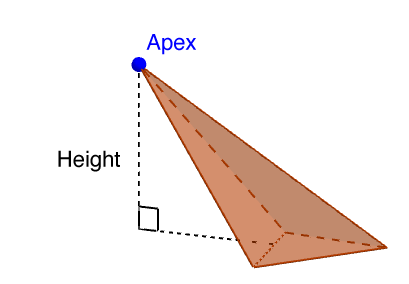Pyramids are solids that have a vertex called the apex. The vertex corresponds to the meeting point of all the triangles that form the lateral faces of the pyramid.
A pyramid is a polyhedron consisting of a single base whose lateral faces are triangles that meet at a vertex, called the apex.
In the following drawings, the major difference between prisms and pyramids can be observed: the lateral faces are triangles, not quadrilaterals.

Like all polyhedrons, pyramids have vertices, faces, and edges. Because of its significance compared to other vertices, the point where all the triangles meet is called the "apex". In addition, to differentiate the height of the pyramid from the height of the triangles of its lateral faces, the term "apothem" is used for the latter.

Note: these terms can also be used to describe a triangle, a cone, and even a regular polygon (apothem).
A pyramid is named according to the polygon at its base. Thus, there are as many names for pyramids as there are polygons. The following table illustrates some typical pyramids.

In this context, the qualifier “regular” refers to the base and the lateral faces which have a particular characteristic.
A regular pyramid is a pyramid with a base that is a regular polygon and whose lateral faces are congruent isosceles triangles.
This means that the apex of a regular pyramid is vertically aligned with the centre of its base.

In each of the drawings, all the sides of each of the bases have the same measurement. Moreover, since the apex is aligned with the centre of the base, the triangles forming the lateral faces are congruent isosceles triangles.
A pyramid can be right or oblique. This depends on whether the height that perpendicularly stems from the apex intersects the middle of the base or not.
A right pyramid is a pyramid where the height from the apex perpendicularly intersects the centre of the base.
Like many solids, right pyramids can be seen in structures made by humans or created by nature.
One of the Seven Wonders of the World is actually a right pyramid: the pyramid of Cheops, in Egypt!

However, not all pyramids are like this.
An oblique pyramid is a pyramid where the height from the apex does not perpendicularly intersect the centre of the base.
Due to the complexity of their construction, oblique pyramids are more difficult to use in everyday life. Here is an example.

As indicated in the definition, the height of the pyramid drawn from the apex does not intersect the centre of the base.

